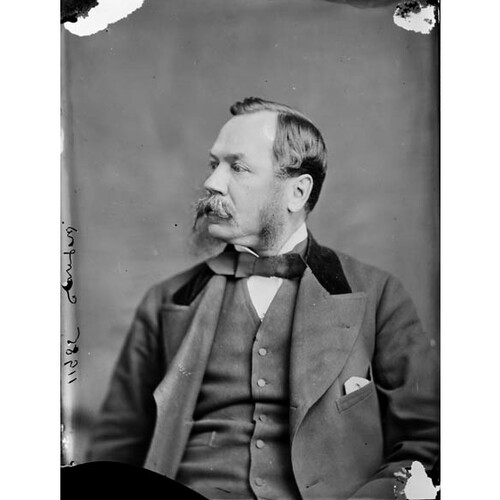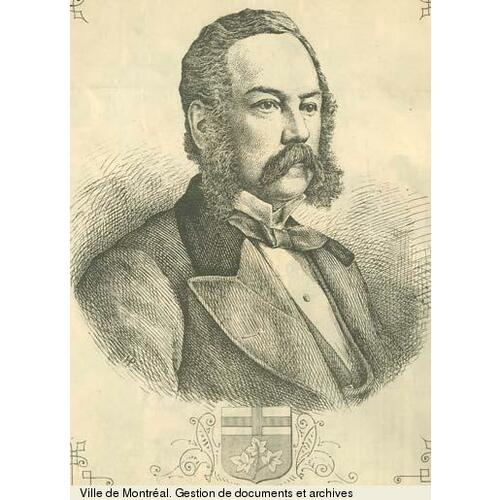CRAWFORD, JOHN WILLOUGHBY, lawyer, businessman, and politician; b. at Manorhamilton, County Leitrim, Ireland, in 1817, son of George Crawford* (later a member of the Canadian Senate) and Margaret Brown; d. in Toronto, Ont., 13 May 1875.
John Willoughby Crawford came to Canada with his parents in 1824. He was raised in Brockville, Upper Canada, where the family had settled and prospered, but was educated at York (Toronto). Called to the bar in 1839, he practised in Toronto and identified himself with that community. In 1845 he married Helen, daughter of Judge Levius Peters Sherwood* of Brockville. They had one son and five daughters.
Although he was in partnership with Ernestus Crombie in a law firm, Crawford’s business activities were so broad that he is more accurately described as a businessman than as a lawyer. His legal specialty was the law of property, banking, and commerce. Associated with numerous business establishments, he served as president of the Royal Canadian Bank, the Imperial Building, Savings and Investment Society, and the Canadian Car Company. He became the first president of the Toronto and Nipissing Railway in 1868 and was a director of the Toronto, Grey and Bruce Railway; both lines were closely involved with Toronto’s metropolitan thrust northward. Crawford was also a director of several other firms, and acted in parliament for the Dominion Express Company and the Empire Fire and Marine Insurance Company.
Relatives and business associates tied Crawford to the politically sensitive Grand Trunk Railway. His father was a director, and his brother James (also an mp, 1867–72) was a contractor to the railway; its long-time president – John Ross – was both a brother-in-law and a business associate; its chief engineer was James Keefer, half-brother of Samuel Keefer*, another brother-in-law; George Sherwood, a third brother-in-law, was also connected with the line. During the 1860s Crawford served the Grand Trunk as a solicitor.
Crawford’s family was also closely involved in politics. His father-in-law was an important eastern Ontario Conservative, and a brother-in-law, Henry Sherwood*, had been a leading Tory politician in the 1840s. Crawford himself entered politics and, although manifesting occasional signs of independence, was a reliable Conservative. His début in politics was dramatic: in 1861 he contested East Toronto against George Brown, arguing that he was an “independent”: “I think it unworthy of the intelligence of an enlightened electoral body to require, as it is unworthy of the self-respect of the candidate entering political life to give, an express pledge of general opposition to or support of, any particular Government.” Crawford wanted the seat of government moved to Toronto and promised that the headquarters of the Grand Trunk would be moved there. Like most people who lived west of Oshawa, however, he disclaimed, albeit disingenuously, any connection with the Grand Trunk. He also declared himself a supporter of representation by population. John Crawford was a powerful businessman, but George Brown was the editor of the Globe and the sitting member. Consequently there was considerable surprise when Crawford defeated Brown 1,135 to 944. He became a loyal and important backbencher.
In 1863 the most significant measure was Richard William Scott*’s bill codifying for the Roman Catholic minority in Canada West most of the educational rights later entrenched in Ontario’s constitution by section 93 of the British North America Act. The bill was vehemently opposed by the bulk of the Canada West members, was a burning question during the 1863 election, and was the main issue in East Toronto. The act was especially important to John Crawford. Although himself a member of the Church of England, he was sensitive to Catholic interests in his constituency, and he supported the act with some courage, one of the few members from Canada West to do so. His associates, according to the Globe, constituted a “motley Catholic crowd,” and his supporters were described as examples of “animal man” – “a credit to the ould sod.” The phrases indicate the tenor of the campaign; Crawford was defeated by 489 votes.
Crawford was ready and anxious to run in the federal election of 1867. In South Leeds, where he had once lived, he won a narrow victory over Albert Norton Richards. When Toronto was allotted a third seat before the election of 1872, Crawford left South Leeds and easily won West Toronto. Then, on 5 Nov. 1873, the day his government resigned, the prime minister, Sir John A. Macdonald*, announced the appointment of John Crawford as lieutenant governor of Ontario. His term was both short and uneventful, and he died at government house, Toronto, in 1875.
John Crawford combined business and public life. His contemporaries assumed that he was a wealthy man, the Ottawa Citizen commenting that “his ventures in landed speculation were very profitable, and at the age of forty [1857] he was independent financially. . . .” He made Toronto’s concerns his own, championing that city even as a member of parliament for South Leeds, and zealously supported its economic interests. He also became a lieutenant-colonel in Toronto’s 5th militia battalion. He was made a qc in 1867 and was elected a bencher of the Law Society of Upper Canada in 1871.
The openness and volatility of 19th century Ontario are illustrated by the Crawford family. In fewer than 50 years the Crawfords moved from the status of an immigrant family to the pinnacle of social leadership involving membership in a tightly knit élite. This was the achievement of a family, but also of an open and receptive society.
PAC, MG 26, A (Macdonald papers), 228, 266; B (Mackenzie papers), ser.2, 1. PAO, Sir Alexander Campbell papers, 1872. Canada, Parliamentary debates, 1873. Globe (Toronto), 1861–75. Leader (Toronto), 1875. Mail (Toronto), 1875. Ottawa Citizen, 1875. PANS, Report, 1952, app. B. Can. biog. dict., I, 23–26. Can. parl. comp., 1873. D. B. Read, The lieutenant-governors of Upper Canada and Ontario, 1792–1899 (Toronto, 1900). Careless, Brown. D. C. Masters, The rise of Toronto, 1850–1890 (Toronto, 1947). M. H. Small, “A study of the dominion and the provincial elections of 1867 in Ontario,” unpublished ma thesis, Queen’s University, 1968. F. A. Walker, Catholic education and politics in Upper Canada; a study of the documentation relative to the origin of Catholic elementary schools in the Ontario school system (Toronto, 1955). D. W. Swainson, “Business and politics: the career of John Willoughby Crawford,” Ont. Hist., LXI (1969), 225–36.
Cite This Article
Donald Swainson, “CRAWFORD, JOHN WILLOUGHBY,” in Dictionary of Canadian Biography, vol. 10, University of Toronto/Université Laval, 2003–, accessed October 17, 2024, https://www.biographi.ca/en/bio/crawford_john_willoughby_10E.html.
The citation above shows the format for footnotes and endnotes according to the Chicago manual of style (16th edition). Information to be used in other citation formats:
| Permalink: | https://www.biographi.ca/en/bio/crawford_john_willoughby_10E.html |
| Author of Article: | Donald Swainson |
| Title of Article: | CRAWFORD, JOHN WILLOUGHBY |
| Publication Name: | Dictionary of Canadian Biography, vol. 10 |
| Publisher: | University of Toronto/Université Laval |
| Year of publication: | 1972 |
| Year of revision: | 1972 |
| Access Date: | October 17, 2024 |





